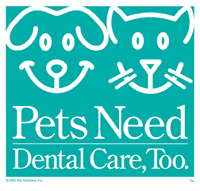February is National Pet Dental Health Month
Did you know that February is National Pet Dental Health Month? According to the American Veterinary Dental College, the professional association for veterinary dentists, most dogs and cats suffer from periodontal disease by the age of three. Periodontal disease occurs when plaque and tartar build up under your pet’s gum line. If left untreated, your pet could develop gingivitis (inflammation of the gums) or even periodontitis (bone and tissue loss around the teeth).
What are the signs of oral health problems in dogs and cats? Common indicators include bad breath, loose or discolored teeth, drooling or bleeding, and loss of appetite.
Home oral hygiene plays an important part in preventing chronic dental problems in dogs and cats. Regular tooth brushing with a brush and toothpaste made for pets is the first step in preventive care. Chlorhexidine, an anti-plaque antiseptic, can be used in both dogs and cats. It comes in rinse or gel form. The rinse gets squirted into the mouth and the gel can be smeared onto the teeth.
Cats and dogs can also benefit from dental diets, which help fight tartar through specially shaped kibble pieces or added anti-tartar ingredients. Look for dental food and treats. Dog rawhide and chew treats as well as chew toys can also help fight tartar.
If your pet needs professional dental care, your vet will need to administer anesthesia to effectively clean below the gum line. While many pet owners would prefer no anesthesia, it is impossible to keep a dog or cat’s head perfectly still during the scaling procedure without the use of anesthesia.
Start introducing your pet to regular home tooth brushings now in order to avoid tooth loss and costly dental treatment later!
Check out the AVDC website for more information.


